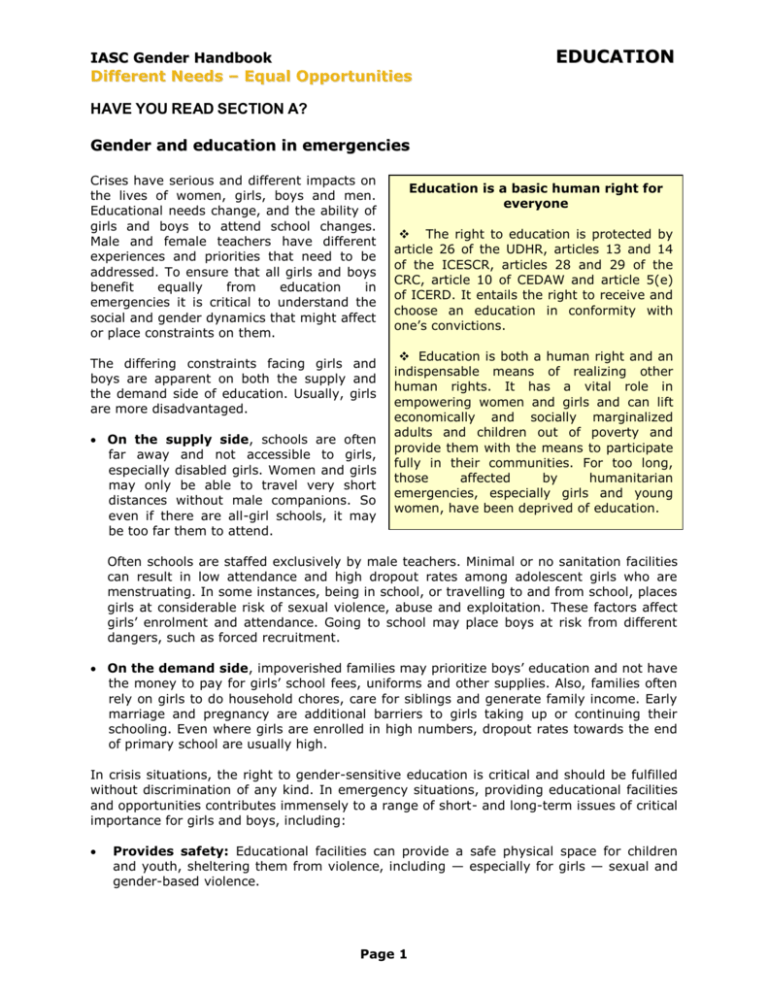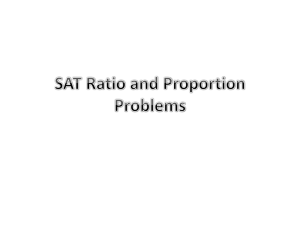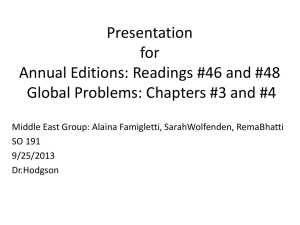
IASC Gender Handbook
Different Needs – Equal Opportunities
EDUCATION
HAVE YOU READ SECTION A?
Gender and education in emergencies
Crises have serious and different impacts on
the lives of women, girls, boys and men.
Educational needs change, and the ability of
girls and boys to attend school changes.
Male and female teachers have different
experiences and priorities that need to be
addressed. To ensure that all girls and boys
benefit
equally
from
education
in
emergencies it is critical to understand the
social and gender dynamics that might affect
or place constraints on them.
The differing constraints facing girls and
boys are apparent on both the supply and
the demand side of education. Usually, girls
are more disadvantaged.
On the supply side, schools are often
far away and not accessible to girls,
especially disabled girls. Women and girls
may only be able to travel very short
distances without male companions. So
even if there are all-girl schools, it may
be too far them to attend.
Education is a basic human right for
everyone
The right to education is protected by
article 26 of the UDHR, articles 13 and 14
of the ICESCR, articles 28 and 29 of the
CRC, article 10 of CEDAW and article 5(e)
of ICERD. It entails the right to receive and
choose an education in conformity with
one’s convictions.
Education is both a human right and an
indispensable means of realizing other
human rights. It has a vital role in
empowering women and girls and can lift
economically and socially marginalized
adults and children out of poverty and
provide them with the means to participate
fully in their communities. For too long,
those
affected
by
humanitarian
emergencies, especially girls and young
women, have been deprived of education.
Often schools are staffed exclusively by male teachers. Minimal or no sanitation facilities
can result in low attendance and high dropout rates among adolescent girls who are
menstruating. In some instances, being in school, or travelling to and from school, places
girls at considerable risk of sexual violence, abuse and exploitation. These factors affect
girls’ enrolment and attendance. Going to school may place boys at risk from different
dangers, such as forced recruitment.
On the demand side, impoverished families may prioritize boys’ education and not have
the money to pay for girls’ school fees, uniforms and other supplies. Also, families often
rely on girls to do household chores, care for siblings and generate family income. Early
marriage and pregnancy are additional barriers to girls taking up or continuing their
schooling. Even where girls are enrolled in high numbers, dropout rates towards the end
of primary school are usually high.
In crisis situations, the right to gender-sensitive education is critical and should be fulfilled
without discrimination of any kind. In emergency situations, providing educational facilities
and opportunities contributes immensely to a range of short- and long-term issues of critical
importance for girls and boys, including:
Provides safety: Educational facilities can provide a safe physical space for children
and youth, sheltering them from violence, including — especially for girls — sexual and
gender-based violence.
Page 1
EDUCATION
IASC Gender Handbook
Different Needs – Equal Opportunities
Promotes well-being and normalcy: Schooling helps to promote and sustain the
physical, social and emotional well-being of all learners. Providing structure and stability
is particularly important for children and youth who may be traumatized by
displacement. Girls and boys have different experiences of the emergency to cope with;
they may also have different coping strategies, and these should be acknowledged and
built on in schools.
Channels health and survival messages: Education in emergencies provides a
channel for conveying health and survival messages; for teaching new skills and values,
such as peace, tolerance, conflict resolution, democracy, human rights and
environmental conservation. An emergency can be a time to show and teach the value
of respecting women, girls, boys and men equally in society.
Builds the future: At the same time, ensuring children and youth access to education
during times of humanitarian emergencies provides the essential foundation for
successful economic, social and political systems upon returning home. It is vital to the
reconstruction of the economic basis of family, local and national life and for sustainable
development and peace building. Ensuring girls’ access to quality education prepares
them to play significant roles in reconstruction efforts in their communities and beyond.
Builds community capacity: Community participation is critical; it can be enhanced
through capacity-building activities with youth leaders and school management
committees. Teacher training and capacity-building support for education officials are
also important, especially in chronic crisis and early reconstruction contexts. These
activities must engage women, girls, boys and men, and be mindful of the differing
perspectives and approaches that women, girls, boys and men may have. Capacitybuilding and training programmes are also a venue to highlight issues of gender
inequality in education so that trainees are more sensitive to the issues and are assisted
in trying to overcome them.
Where this window of opportunity for gender-responsive education in emergencies is seized,
it can also result in long-term changes in educational systems, in relationships and in
power- and opportunity-sharing between women, girls, boys and men.
Using a gender lens when planning education: How to do it
Basic information about the numbers of girls and boys,
their location and the cultural context in which you are
operating
can
help
improve
your
programming.
Information about their experiences is also important. For
example how many were involved with fighting forces?
How many girl-mothers are there? What responsibilities
are they shouldering now? Often girls (particularly girlmothers) are unable to attend school as they are the sole
caretakers of their families. The provision of child care
facilities, food and shelter are means to ensure these girls
can enrol in school.
Teacher Qualifications
In many situations, such as
Timor Leste, the formal
qualifications required for
teachers resulted in the
exclusion
of
many
experienced female teachers
who did not have formal
training.
The location of schools and time of classes can have different impacts on different groups. If
girls and young women cannot walk alone, you may need to provide escorts or protection to
and from school. From the standpoint of teachers, it is important to consider issues such as
recruitment and training from a gender perspective.
Page 2
IASC Gender Handbook
Different Needs – Equal Opportunities
EDUCATION
What do we need to know to design and implement genderresponsive education in emergencies?
Note: This section is based on, and should be used with, the checklist from the INEE
Minimum Standards for Education in Emergencies, Chronic Crises and Early Reconstruction
handbook, p.33.
What is the nature of the crisis and its impact on education?
What is the impact of the crisis on the lives of girls and boys (e.g. recruitment,
abduction, increased household chores), including access to education?
How has the crisis affected women and men, including teachers?
What has been the impact on education in the host community?
What are the education-related demographics?
Number of displaced girls and boys. Where are they? Are they in camps or not? How
long have they been there?
Numbers of girls and boys in the host communities and their access to education.
Breakdown by sex and age and, if relevant, by ethnic group for all levels (pre-school,
primary, secondary).
What is the economic situation of families and how does this affect girls and boys?
Number of girls or boys heading households. Number of girl-mothers.
Number of girls and boys separated from their family. Where are they living? Are they
caring for others, or being cared for?
Number of out-of-school adolescent girls and boys.
Literacy rates for women and men.
What has changed?
Explain any differences between current and pre-emergency scenarios from a gender
perspective in regards to education. Will the emphasis be on re-enrolment and retention
or on new enrolments and retention?
What languages are used by the children?
What is the mother tongue/other languages spoken? Written?
Do girls and women have the same proficiency in any “official” language as boys and
men?
What are the safety and access issues for the learning environments?
Are women and men involved in decisions regarding the location of learning
environments?
Are the possible locations equally accessible to girls and boys (e.g. in a mosque) and at
all levels of schooling (i.e. not only lower grades)?
Are there girls and boys suffering from stigma because of specific war experiences (e.g.
rape survivors, ex-child soldiers)? Does the stigma prohibit access to education?
What are the direct and indirect costs for girls and boys to attend school?
Is the distance to be travelled to school acceptable to parents for girls? Boys? Is the
route to school safe for girls and boys?
What safety precautions are expected for girls by the parents?
Are learning environments secure, and do they promote the protection and mental and
emotional well-being of learners?
Are latrines accessible, located safely and adequate in number? Are there separate
latrines for girls and boys? Is water available?
If required, can sanitary pads be made available in schools?
Page 3
IASC Gender Handbook
Different Needs – Equal Opportunities
EDUCATION
Has a code of conduct for teachers and other education personnel that addresses sexual
harassment, abuse and exploitation been developed in a participatory manner and
signed and followed? Are appropriate measures documented and applied in cases of
misconduct and/or violations of the code of conduct?
What is the division of household chores and other work?
What sort of work do girls and boys typically do?
How many hours a day? What time of day?
Where does it take place? (At home? In fields?)
Does this work put girls and boys at any serious risk?
Does it interfere with the school day and work?
What learning materials exist?
Do they provide critical information on issues such as self-protection, landmines, etc.?
Are the learning materials inclusive of and relevant to girls? Do they perpetuate gender
stereotypes?
What is the situation with teachers, training, support and materials?
Are male and female teachers available? At all grade levels? What are their levels of
qualification and experience?
Are there para-professionals? Other women in the community who could support girls in
school and be involved in teaching and/or mentoring?
Are teaching materials and trainings available to help teachers address specific topics
needed by girls and boys (e.g. sexual and reproductive health)?
Are there female teacher trainers and support staff?
What is the situation regarding parental/community involvement (in education)?
Do Parent Teacher Associations (PTAs) — or similar — exist? To what extent are women
and men involved? Are there any cultural restrictions on women’s involvement?
Has training been provided to the PTA? If so, has gender been addressed?
What is the history of overcoming gender-based obstacles in the community? Which
community members have been active and how?
What are the gender-specific vulnerabilities and protection needs?
Are there groups of girls who are doubly disadvantaged (e.g. disabled girls, young
mothers, former girl soldiers)?
Are messages conveyed in a gender-sensitive manner for topics such as HIV/AIDS and
STI, early pregnancy and childbirth, child and baby care, healthy menstruation
management and GBV?
Is information provided on reporting mechanisms and follow-up for harassment and
GBV? Are there gender- and age-responsive materials and services available to support
survivors of GBV and are these linked to the school?
Actions to ensure gender equality programming in education
Community participation
Sensitize communities to the importance of girls’ and women’s access to education,
especially in emergencies.
Develop strategies to ensure that women, girls, boys and men actively participate in
education meetings and in trainings (e.g. pay attention to appropriate meeting timings
and locations, provide child care facilities and consider single-sex meetings).
Include women and men on community education committees and provide gender
training if necessary to ensure their voices are heard and taken seriously.
Page 4
IASC Gender Handbook
Different Needs – Equal Opportunities
EDUCATION
Engage women and men in school-related activities such as school feeding, arranging
escorts to school, parents’ mobilization.
Engage the local community, especially women and girls, in the design and location of
school sanitation facilities.
Analysis
Include gender dimensions in the initial assessment and ongoing monitoring and
evaluation of education in emergencies.
Collect and analyse all data related to education by sex and age.
Consult regularly with women, girls, boys and men as part of monitoring and evaluation
activities.
Access and learning environment
In refugee and IDP contexts, provide access to education for all girls and boys.
Create access for all to quality and relevant education opportunities; pay particular
attention to marginalized girls and boys (e.g. girl-mothers, working boys and former girl
soldiers) and provide flexibility and “open” programmes, with early childhood education
programmes if needed.
Set the hours for classes at convenient times for those children involved with household
chores and field work.
Involve female and male youth in the development and implementation of varied
recreational and sports activities and ensure their constructive initiatives are supported
by relevant stakeholders.
Provide other gender-specific extra-curricular activities that promote resilience and
healing for girls and boys in emergencies.
Ensure that learning environments are secure and promote the protection and physical,
mental and emotional well-being of learners. Pay particular attention to disproportionate
impacts of insecurity on girls and women and vulnerability to GBV (e.g. provide escorts
to and from school for girls, employ classroom assistants, provide girls with reporting
guidelines and follow-up procedures, establish codes of conduct for teachers).
Monitor sexual harassment; provide confidential complaint reporting mechanisms and
follow-up with clear procedures.
Where single-sex classes are preferred, provide separate classrooms/locations or timings
for girls and boys.
Provide separate female and male latrines — in safe places.
Provide appropriate clothing and sanitary supplies to girls so they can attend school and
fully participate in class.
Teaching and learning
Promote learner-centred, participatory and inclusive instruction, reaching out to and
engaging girls actively in class.
Develop gender-sensitive curricula addressing the specific needs, perspectives and
experiences of girls and boys, including reproductive health and HIV/AIDS content.
Ensure learning materials such as “School in a Box” and other emergency kits are
gender sensitive and responsive to girls’ and boys’ needs
Include gender equality and gender-sensitive teaching strategies in teacher training
courses to ensure that teachers are able to create gender-sensitive learning
environments.
Establish ethical assessment and examination processes that protect women and girls
(e.g. ensure teachers cannot use grade allocation to exploit girls).
Teachers and other education personnel
Page 5
IASC Gender Handbook
Different Needs – Equal Opportunities
EDUCATION
Work with the community to develop and implement a code of conduct for teachers and
other education personnel that addresses sexual harassment, abuse and exploitation.
Ensure that it is consistently applied and that appropriate and agreed-upon measures
are documented and applied in cases of misconduct and/or violation of the code of
conduct.
Use creative strategies to proactively recruit and retain women teachers (e.g. entry
through classroom assistants programme, part-time positions).
Ensure that women teachers are equally able to participate in school meetings and
professional development (e.g. select timing carefully and provide child care).
Where possible, ensure that women teachers are placed in high-profile positions (not
only in early year classes and “soft” subjects).
Include gender equality and girl-friendly teaching strategies in the criteria for teacher
supervision.
Education policy and coordination
Advocate for policy decisions to reduce the cost of schooling, especially for girls’ families
(e.g. feeding programmes, take-home rations and items).
Consider how resources can be coordinated (inter-agency, inter-organization) to expand
programming to include hard-to-reach girls (e.g. IDPs, young mothers, urban refugees).
Include specific commitment to gender equality in coordination statements/agreements
between partners (e.g. UNHCR, NGOs and governments).
Explicitly locate emergency education within the CRC, Education for All and Millennium
Development Goals (MDG) frameworks.
Support and promote education policies and laws that protect against gender
discrimination in education.
Ensure commitment from education partners to common standards of culturally and
gender-sensitive project implementation and management from the outset.
Checklist for assessing gender equality programming in the
education sector
Educators should review the list below and select the items relevant to your context to
develop measurable indicators. For further reference, the INEE Minimum Standards for
Education in Emergencies, Chronic Crises and Early Reconstruction provide a broader set of
indicators.
Education — Gender Checklist
Community participation
1. Number of women and men involved in community education committees on a
regular basis.
2. Number of women and men involved in community education plans.
3. Number and type of gender-specific issues in education plans.
4. Percentage of girls involved in child/youth participation activities.
5. Number of community members provided with gender training.
Analysis
1. Percentage of relevant and available sex- and age-disaggregated data collected.
2. Number and type of references to gender-specific issues in assessment planning,
tools design and data analysis.
3. Number of women, girls, boys and men consulted in assessment, monitoring and
evaluation processes.
Access and learning environment
1. Net enrolment ratio of girls and boys.
2. Sex-disaggregated enrolment rates by grade level.
Page 6
IASC Gender Handbook
Different Needs – Equal Opportunities
EDUCATION
3. Sex-disaggregated school attendance rates.
4. Sex- and grade level-disaggregated dropout rates.
5. Number of reported incidents of sexual abuse and exploitation.
6. Existence of a “safe school” policy with clear implementation actions.
Teaching and learning
1. Percentage of teachers who demonstrate attempts to create girl-friendly classroom
environments and use teaching strategies to engage girls.
2. Number of gender-specific lessons and topics in the school curriculum.
3. Sex-disaggregated achievement measures (e.g. exam results).
4. Percentage of teachers (women/men) involved in in-service training.
5. Number of women/men involved in pre-service teacher programmes.
6. Percentage of teachers (women/men) provided with gender training.
Teachers and other education personnel
1. Number of male and female teachers, head teachers, teacher trainers/supervisors
and other educational personnel (disaggregated by ethnic/caste groups).
2. Percentage of women teachers who feel safe and are respected in school and in the
community and are fully involved in education decision-making.
4. Percentage of teachers (women/men) trained on and have signed a code of conduct.
Education policy and coordination
1. Number and type of references to gender-specific issues in coordination meetings.
2. Number and type of references to gender-specific issues in coordination
statements/agreements.
3. Development of materials that address/challenge gender stereotypes and reflect new
realities in society.
Resources
1.
2.
3.
4.
5.
6.
7.
8.
9.
Mugisha, Catherine Howgego. Gender Imbalance in Secondary Schools. Forced
Migration Review 22. January 2005.
http://www.fmreview.org/FMRpdfs/FMR22/FMR2216.pdf
Inter-Agency Network for Education in Emergencies (INEE). www.ineesite.org
INEE. Good Practice Guide: Towards gender equality/girls and women’s education.
http://www.ineesite.org/page.asp?pid=1149
INEE. Minimum Standards for Education in Emergencies, Chronic Crises and Early
Reconstruction. December 2004. http://www.ineesite.org/standards/MSEE_report.pdf
International Institute for Educational Planning — UNESCO. The Guidebook for Planning
Education in Emergencies and Reconstruction (Chapter 6: Gender). 2006.
http://www.unesco.org/iiep/eng/focus/emergency/guidebook.htm
Kirk, Jackie. Advocacy Brief: Education in Emergencies: The Gender Implications.
UNESCO, Bangkok, 2006. http://www2.unescobkk.org/elib/publications/092/
Kirk, Jackie. Teachers Creating Change: Working for Girls’ Education and Gender Equity
in South Sudan. Equals, Beyond Access: Gender, Education and Development.
November/December 2004.
http://k1.ioe.ac.uk/schools/efps/GenderEducDev/IOE%20EQUALS%20NO.9.pdf
Kirk, Jackie. Promoting a Gender-Just Peace: the Roles of Women Teachers in Peace
Building and Reconstruction. Gender and Development. November 2004.
http://www.oxfam.org.uk/what_we_do/resources/downloads/gender_peacebuilding_an
d_reconstruction_kirk.pdf
Sinclair, Margaret. Planning Education In and After Emergencies. 2002.
Available for purchase from http://www.unesco.org/iiep/eng/publications/pubs.htm
Page 7
IASC Gender Handbook
Different Needs – Equal Opportunities
EDUCATION
10. Women's Commission for Refugee Women and Children. Don’t Forget Us: The Education
and Gender-Based Violence Protection Needs of Adolescent Girls from Darfur in Chad. July
2005. http://www.womenscommission.org/pdf/Td_ed2.pdf
11. Women's Commission for Refugee Women and Children. Right to Education during
Displacement. A resource for organizations working with refugees and internally displaced
persons. New York, 2006. http://www.womenscommission.org/pdf/right_to_ed.pdf
For more information, please visit
Inter-Agency Network for Education in Emergencies www.ineesite.org
Page 8









